ad blue FORD TRANSIT 2020 User Guide
[x] Cancel search | Manufacturer: FORD, Model Year: 2020, Model line: TRANSIT, Model: FORD TRANSIT 2020Pages: 529, PDF Size: 8.3 MB
Page 247 of 529
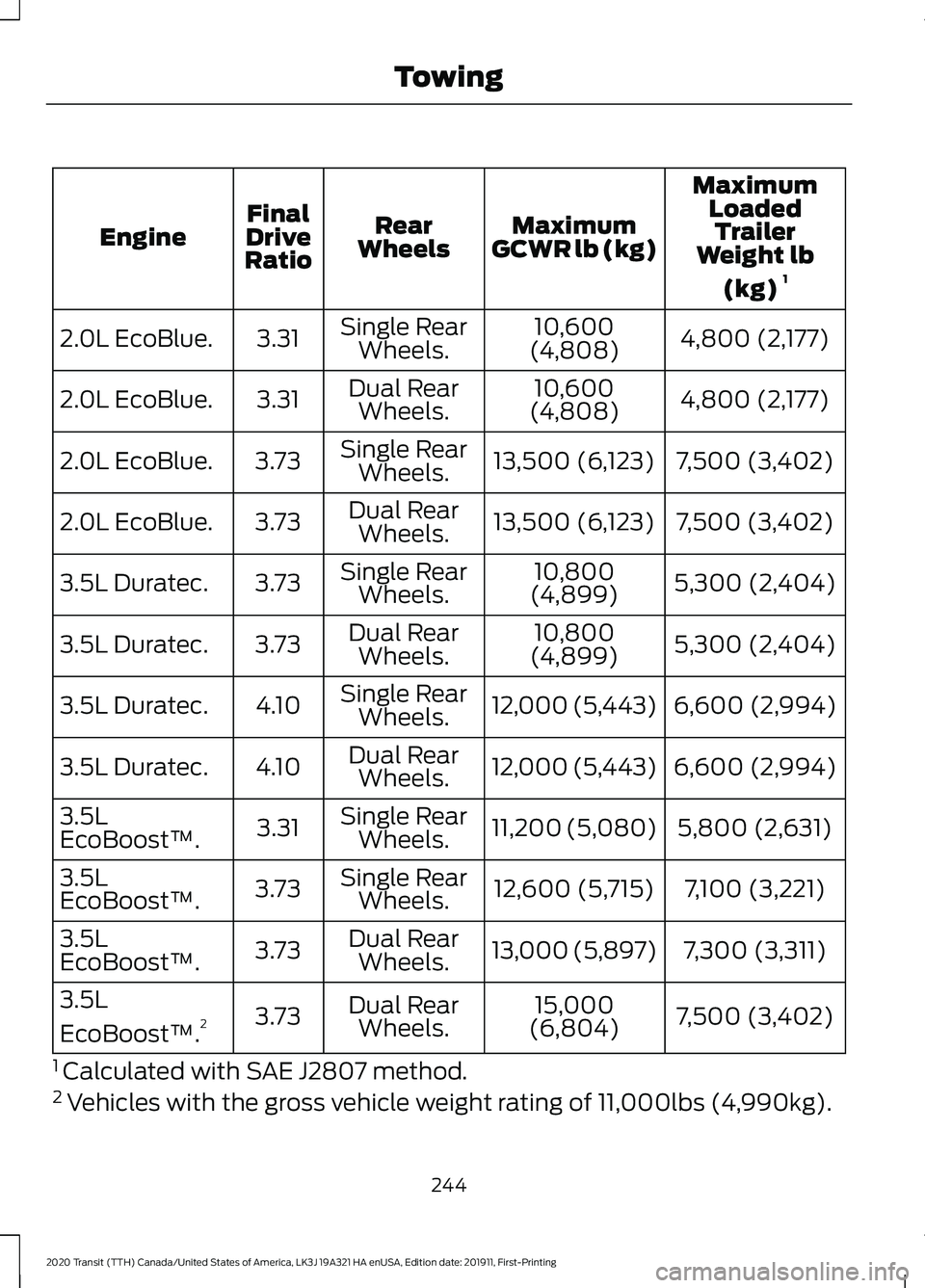
Maximum
LoadedTrailer
Weight lb
(kg) 1
Maximum
GCWR lb (kg)
Rear
Wheels
Final
Drive
Ratio
Engine
4,800 (2,177)
10,600
(4,808)
Single Rear
Wheels.
3.31
2.0L EcoBlue.
4,800 (2,177)
10,600
(4,808)
Dual Rear
Wheels.
3.31
2.0L EcoBlue.
7,500 (3,402)
13,500 (6,123)
Single Rear
Wheels.
3.73
2.0L EcoBlue.
7,500 (3,402)
13,500 (6,123)
Dual Rear
Wheels.
3.73
2.0L EcoBlue.
5,300 (2,404)
10,800
(4,899)
Single Rear
Wheels.
3.73
3.5L Duratec.
5,300 (2,404)
10,800
(4,899)
Dual Rear
Wheels.
3.73
3.5L Duratec.
6,600 (2,994)
12,000 (5,443)
Single Rear
Wheels.
4.10
3.5L Duratec.
6,600 (2,994)
12,000 (5,443)
Dual Rear
Wheels.
4.10
3.5L Duratec.
5,800 (2,631)
11,200 (5,080)
Single Rear
Wheels.
3.31
3.5L
EcoBoost™.
7,100 (3,221)
12,600 (5,715)
Single Rear
Wheels.
3.73
3.5L
EcoBoost™.
7,300 (3,311)
13,000 (5,897)
Dual Rear
Wheels.
3.73
3.5L
EcoBoost™.
7,500 (3,402)
15,000
(6,804)
Dual Rear
Wheels.
3.73
3.5L
EcoBoost™.
2
1 Calculated with SAE J2807 method.
2 Vehicles with the gross vehicle weight rating of 11,000lbs (4,990kg).
244
2020 Transit (TTH) Canada/United States of America, LK3J 19A321 HA enUSA, Edition date: 201911, First-Printing Towing
Page 249 of 529
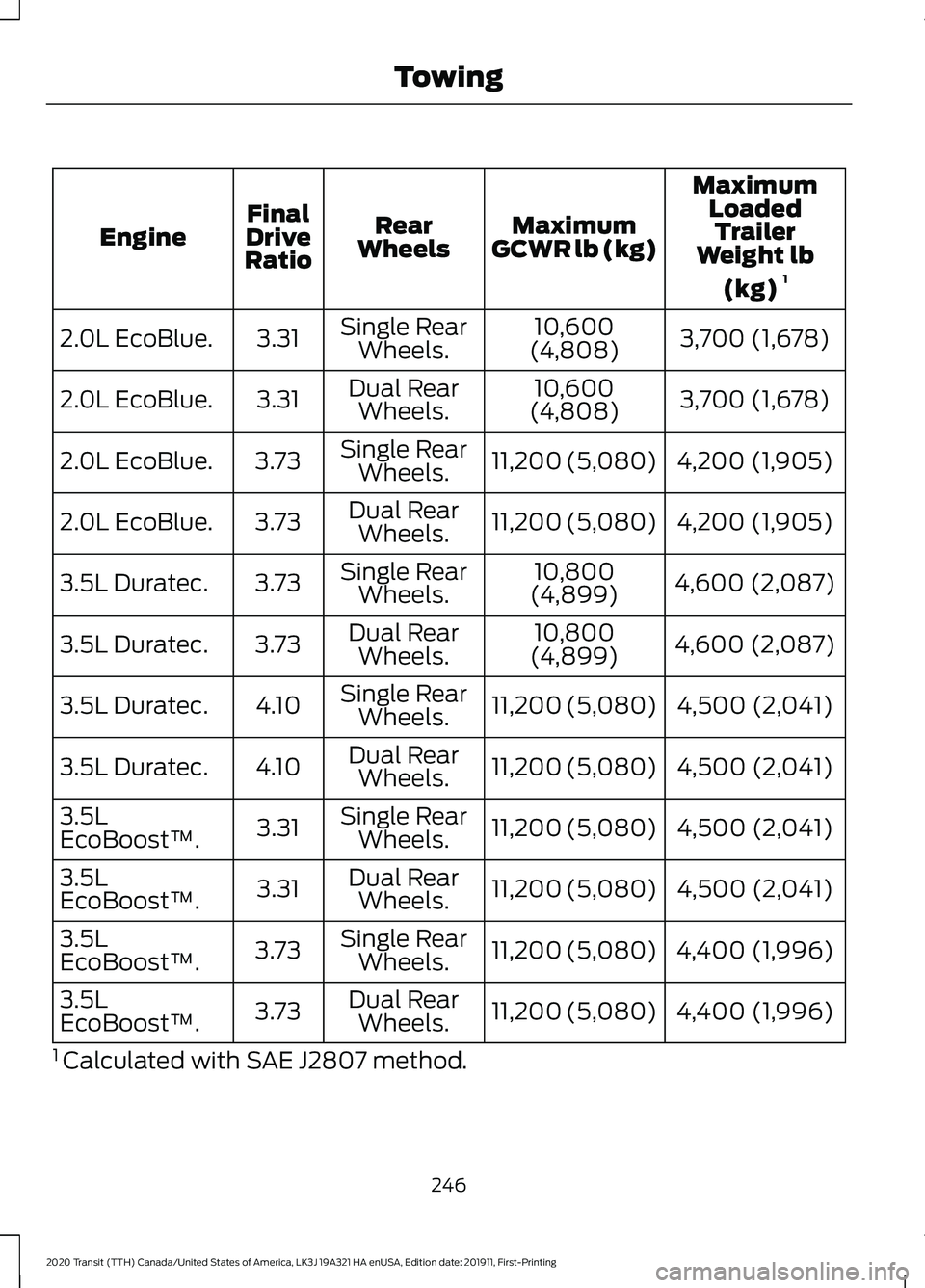
Maximum
LoadedTrailer
Weight lb
(kg) 1
Maximum
GCWR lb (kg)
Rear
Wheels
Final
Drive
Ratio
Engine
3,700 (1,678)
10,600
(4,808)
Single Rear
Wheels.
3.31
2.0L EcoBlue.
3,700 (1,678)
10,600
(4,808)
Dual Rear
Wheels.
3.31
2.0L EcoBlue.
4,200 (1,905)
11,200 (5,080)
Single Rear
Wheels.
3.73
2.0L EcoBlue.
4,200 (1,905)
11,200 (5,080)
Dual Rear
Wheels.
3.73
2.0L EcoBlue.
4,600 (2,087)
10,800
(4,899)
Single Rear
Wheels.
3.73
3.5L Duratec.
4,600 (2,087)
10,800
(4,899)
Dual Rear
Wheels.
3.73
3.5L Duratec.
4,500 (2,041)
11,200 (5,080)
Single Rear
Wheels.
4.10
3.5L Duratec.
4,500 (2,041)
11,200 (5,080)
Dual Rear
Wheels.
4.10
3.5L Duratec.
4,500 (2,041)
11,200 (5,080)
Single Rear
Wheels.
3.31
3.5L
EcoBoost™.
4,500 (2,041)
11,200 (5,080)
Dual Rear
Wheels.
3.31
3.5L
EcoBoost™.
4,400 (1,996)
11,200 (5,080)
Single Rear
Wheels.
3.73
3.5L
EcoBoost™.
4,400 (1,996)
11,200 (5,080)
Dual Rear
Wheels.
3.73
3.5L
EcoBoost™.
1 Calculated with SAE J2807 method.
246
2020 Transit (TTH) Canada/United States of America, LK3J 19A321 HA enUSA, Edition date: 201911, First-Printing Towing
Page 251 of 529
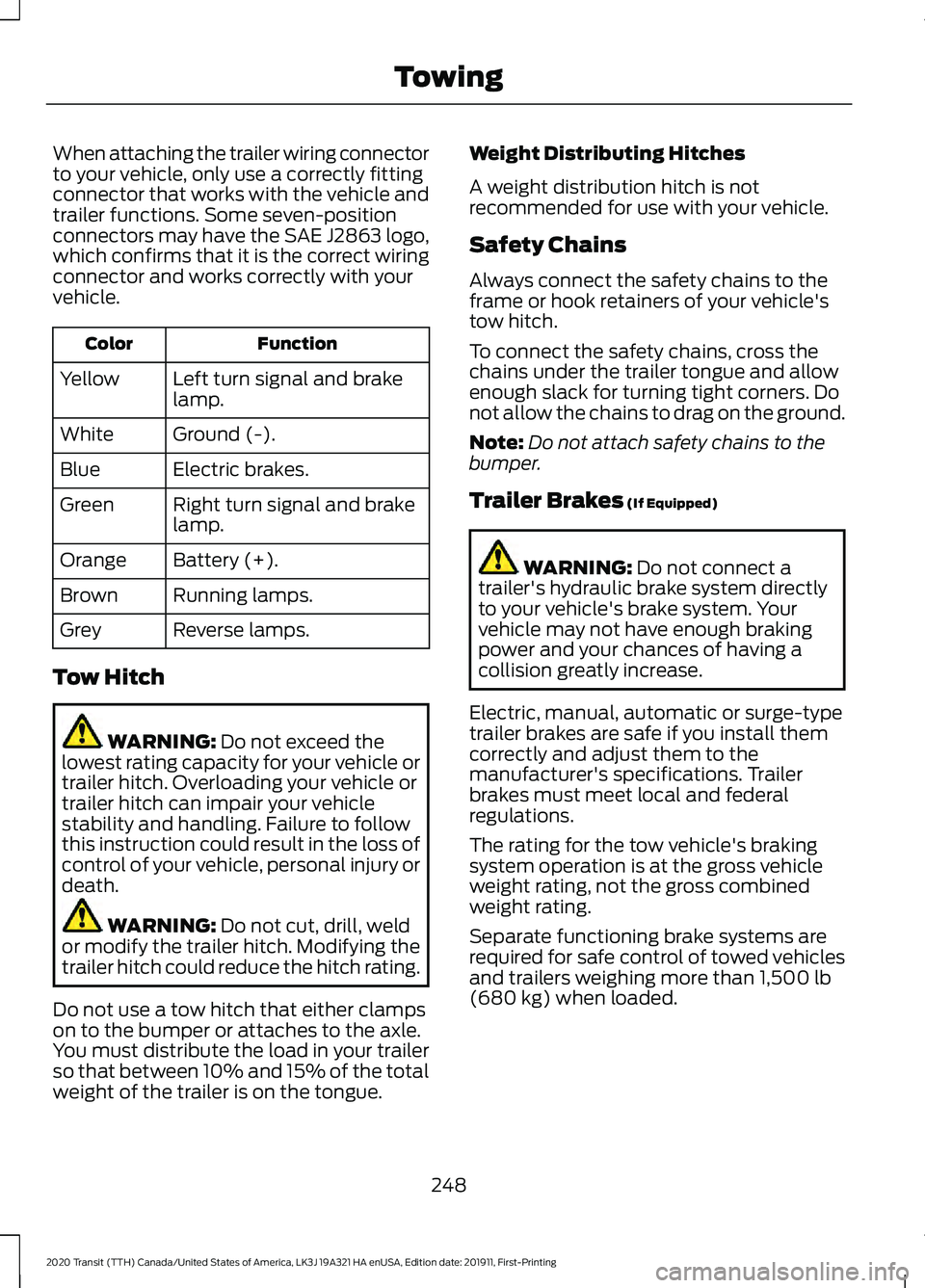
When attaching the trailer wiring connector
to your vehicle, only use a correctly fitting
connector that works with the vehicle and
trailer functions. Some seven-position
connectors may have the SAE J2863 logo,
which confirms that it is the correct wiring
connector and works correctly with your
vehicle.
Function
Color
Left turn signal and brake
lamp.
Yellow
Ground (-).
White
Electric brakes.
Blue
Right turn signal and brake
lamp.
Green
Battery (+).
Orange
Running lamps.
Brown
Reverse lamps.
Grey
Tow Hitch WARNING: Do not exceed the
lowest rating capacity for your vehicle or
trailer hitch. Overloading your vehicle or
trailer hitch can impair your vehicle
stability and handling. Failure to follow
this instruction could result in the loss of
control of your vehicle, personal injury or
death. WARNING:
Do not cut, drill, weld
or modify the trailer hitch. Modifying the
trailer hitch could reduce the hitch rating.
Do not use a tow hitch that either clamps
on to the bumper or attaches to the axle.
You must distribute the load in your trailer
so that between 10% and 15% of the total
weight of the trailer is on the tongue. Weight Distributing Hitches
A weight distribution hitch is not
recommended for use with your vehicle.
Safety Chains
Always connect the safety chains to the
frame or hook retainers of your vehicle's
tow hitch.
To connect the safety chains, cross the
chains under the trailer tongue and allow
enough slack for turning tight corners. Do
not allow the chains to drag on the ground.
Note:
Do not attach safety chains to the
bumper.
Trailer Brakes
(If Equipped) WARNING:
Do not connect a
trailer's hydraulic brake system directly
to your vehicle's brake system. Your
vehicle may not have enough braking
power and your chances of having a
collision greatly increase.
Electric, manual, automatic or surge-type
trailer brakes are safe if you install them
correctly and adjust them to the
manufacturer's specifications. Trailer
brakes must meet local and federal
regulations.
The rating for the tow vehicle's braking
system operation is at the gross vehicle
weight rating, not the gross combined
weight rating.
Separate functioning brake systems are
required for safe control of towed vehicles
and trailers weighing more than
1,500 lb
(680 kg) when loaded.
248
2020 Transit (TTH) Canada/United States of America, LK3J 19A321 HA enUSA, Edition date: 201911, First-Printing Towing
Page 262 of 529

Note:
Various system checks are
automatically carried out before the vehicle
will restart. if your vehicle fails to restart
after the third attempt, the system has
detected a fault that requires service. We
recommend you contact an authorized
dealer.
Keyless Starting (If Equipped)
1. Without applying the brake pedal, press and release the button once.
2. Press the brake pedal, and then press and release the button once.
3. Without applying the brake pedal, press and release the button once.
4. Press the brake pedal and then press the button until the engine starts.
Note: Various system checks are
automatically carried out before the vehicle
will restart. if your vehicle fails to restart
after the third attempt, the system has
detected a fault that requires service. We
recommend you contact an authorized
dealer.
JUMP STARTING THE VEHICLE
- 2.0L ECOBLUE WARNING: Connect batteries with
only the same nominal voltage. WARNING:
Use only adequately
sized cables with insulated clamps.
Note: Do not disconnect the battery of the
disabled vehicle as this could damage the
vehicle electrical system. Connecting the Jumper Cables
Vehicle with the discharged
battery.
A
Vehicle with the booster battery.
B
Positive jumper cable.
C
Negative jumper cable.
D
Front Wheel Drive
1. Switch the ignition off and any electrical equipment.
259
2020 Transit (TTH) Canada/United States of America, LK3J 19A321 HA enUSA, Edition date: 201911, First-Printing Roadside EmergenciesA
B
CD
E102925
Page 293 of 529
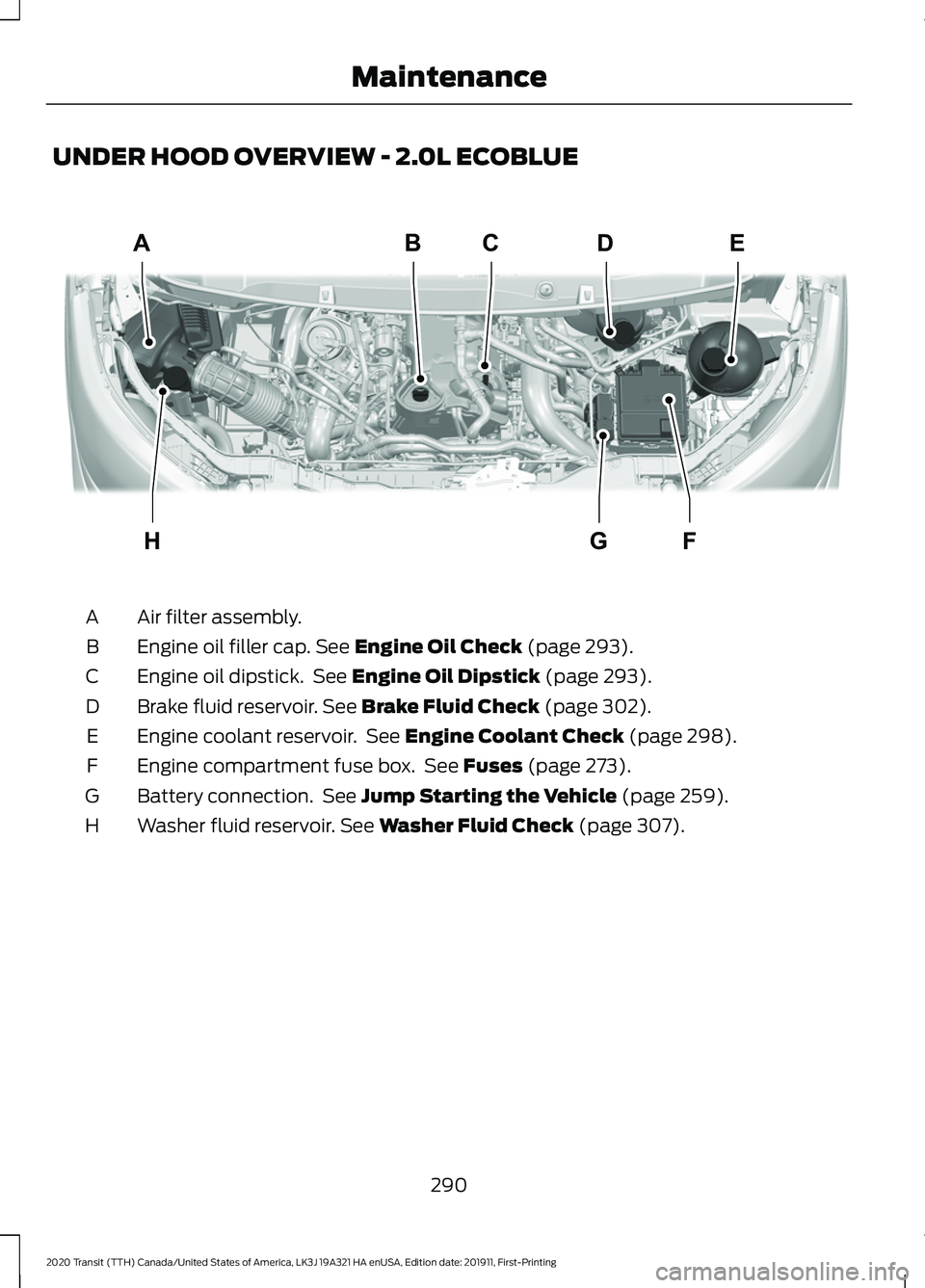
UNDER HOOD OVERVIEW - 2.0L ECOBLUE
Air filter assembly.
A
Engine oil filler cap. See Engine Oil Check (page 293).
B
Engine oil dipstick. See
Engine Oil Dipstick (page 293).
C
Brake fluid reservoir.
See Brake Fluid Check (page 302).
D
Engine coolant reservoir. See
Engine Coolant Check (page 298).
E
Engine compartment fuse box. See
Fuses (page 273).
F
Battery connection. See
Jump Starting the Vehicle (page 259).
G
Washer fluid reservoir.
See Washer Fluid Check (page 307).
H
290
2020 Transit (TTH) Canada/United States of America, LK3J 19A321 HA enUSA, Edition date: 201911, First-Printing MaintenanceABCDE
FGHE306490
Page 296 of 529
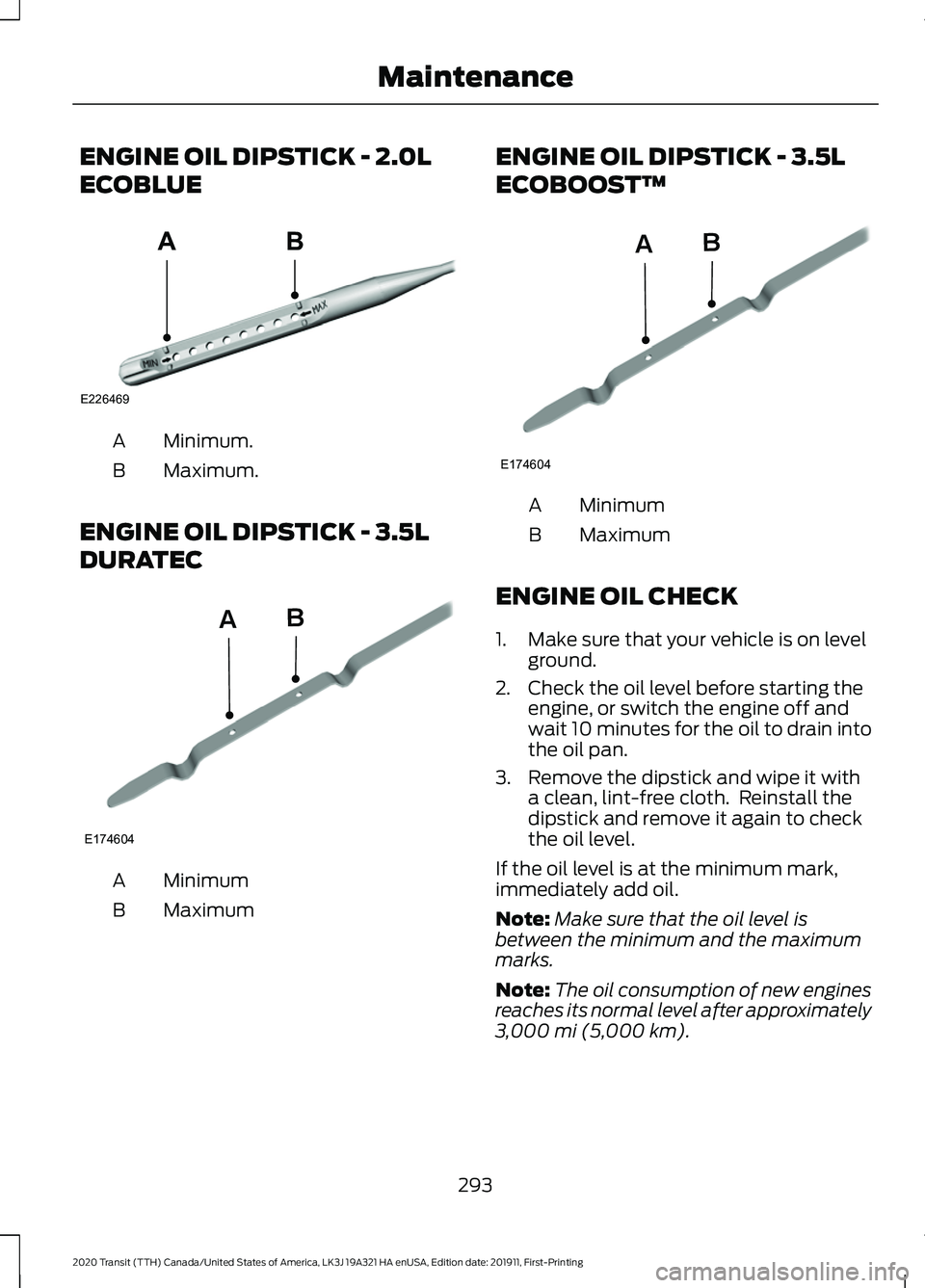
ENGINE OIL DIPSTICK - 2.0L
ECOBLUE
Minimum.
A
Maximum.
B
ENGINE OIL DIPSTICK - 3.5L
DURATEC Minimum
A
Maximum
B ENGINE OIL DIPSTICK - 3.5L
ECOBOOST™
Minimum
A
Maximum
B
ENGINE OIL CHECK
1. Make sure that your vehicle is on level ground.
2. Check the oil level before starting the engine, or switch the engine off and
wait 10 minutes for the oil to drain into
the oil pan.
3. Remove the dipstick and wipe it with a clean, lint-free cloth. Reinstall the
dipstick and remove it again to check
the oil level.
If the oil level is at the minimum mark,
immediately add oil.
Note: Make sure that the oil level is
between the minimum and the maximum
marks.
Note: The oil consumption of new engines
reaches its normal level after approximately
3,000 mi (5,000 km).
293
2020 Transit (TTH) Canada/United States of America, LK3J 19A321 HA enUSA, Edition date: 201911, First-Printing MaintenanceE226469
AB E174604
AB E174604
AB
Page 316 of 529
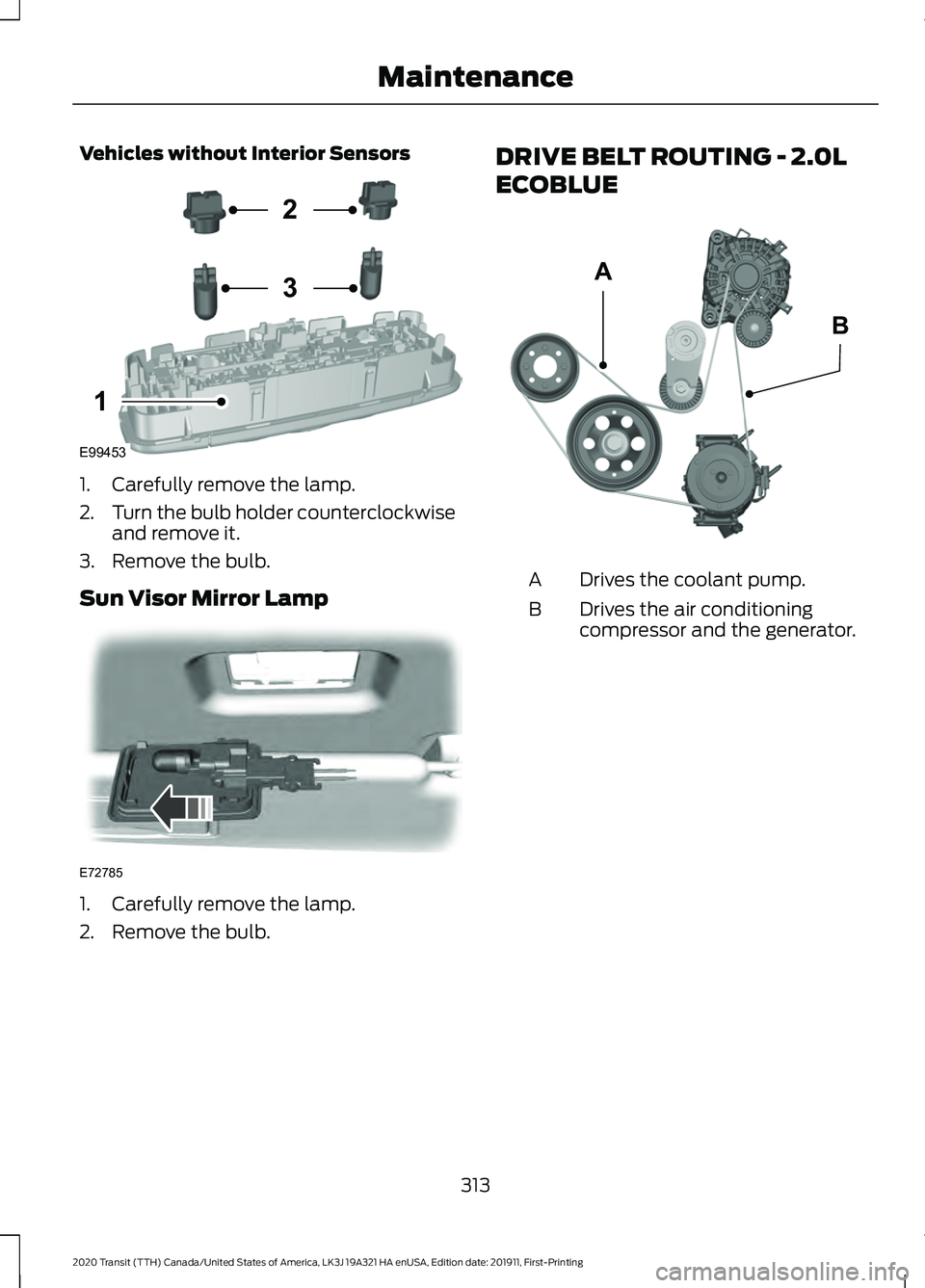
Vehicles without Interior Sensors
1. Carefully remove the lamp.
2.
Turn the bulb holder counterclockwise
and remove it.
3. Remove the bulb.
Sun Visor Mirror Lamp 1. Carefully remove the lamp.
2. Remove the bulb. DRIVE BELT ROUTING - 2.0L
ECOBLUE
Drives the coolant pump.
A
Drives the air conditioning
compressor and the generator.
B
313
2020 Transit (TTH) Canada/United States of America, LK3J 19A321 HA enUSA, Edition date: 201911, First-Printing MaintenanceE99453
2
3
1 E72785 A
BE309422
Page 365 of 529
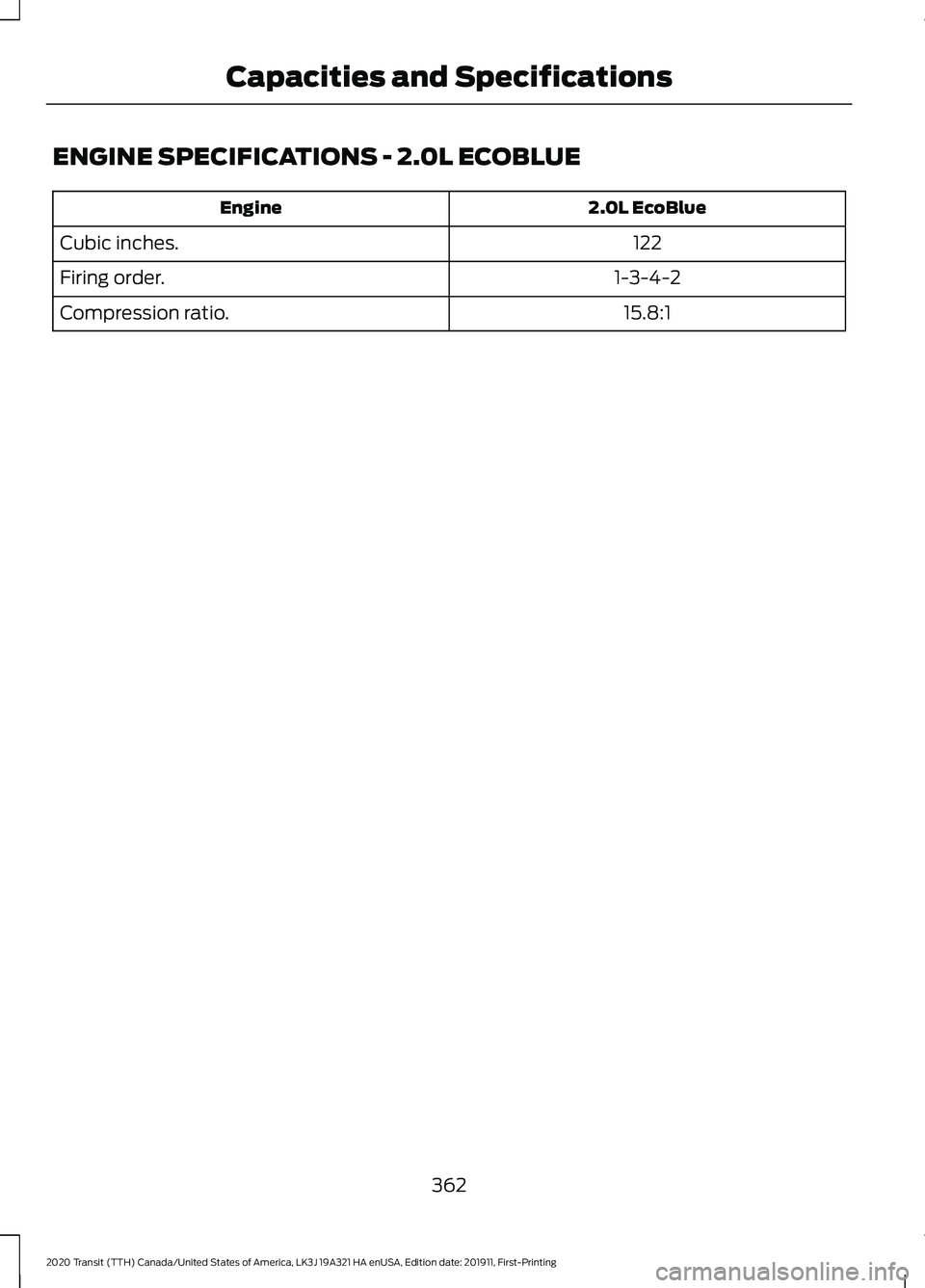
ENGINE SPECIFICATIONS - 2.0L ECOBLUE
2.0L EcoBlue
Engine
122
Cubic inches.
1-3-4-2
Firing order.
15.8:1
Compression ratio.
362
2020 Transit (TTH) Canada/United States of America, LK3J 19A321 HA enUSA, Edition date: 201911, First-Printing Capacities and Specifications
Page 368 of 529
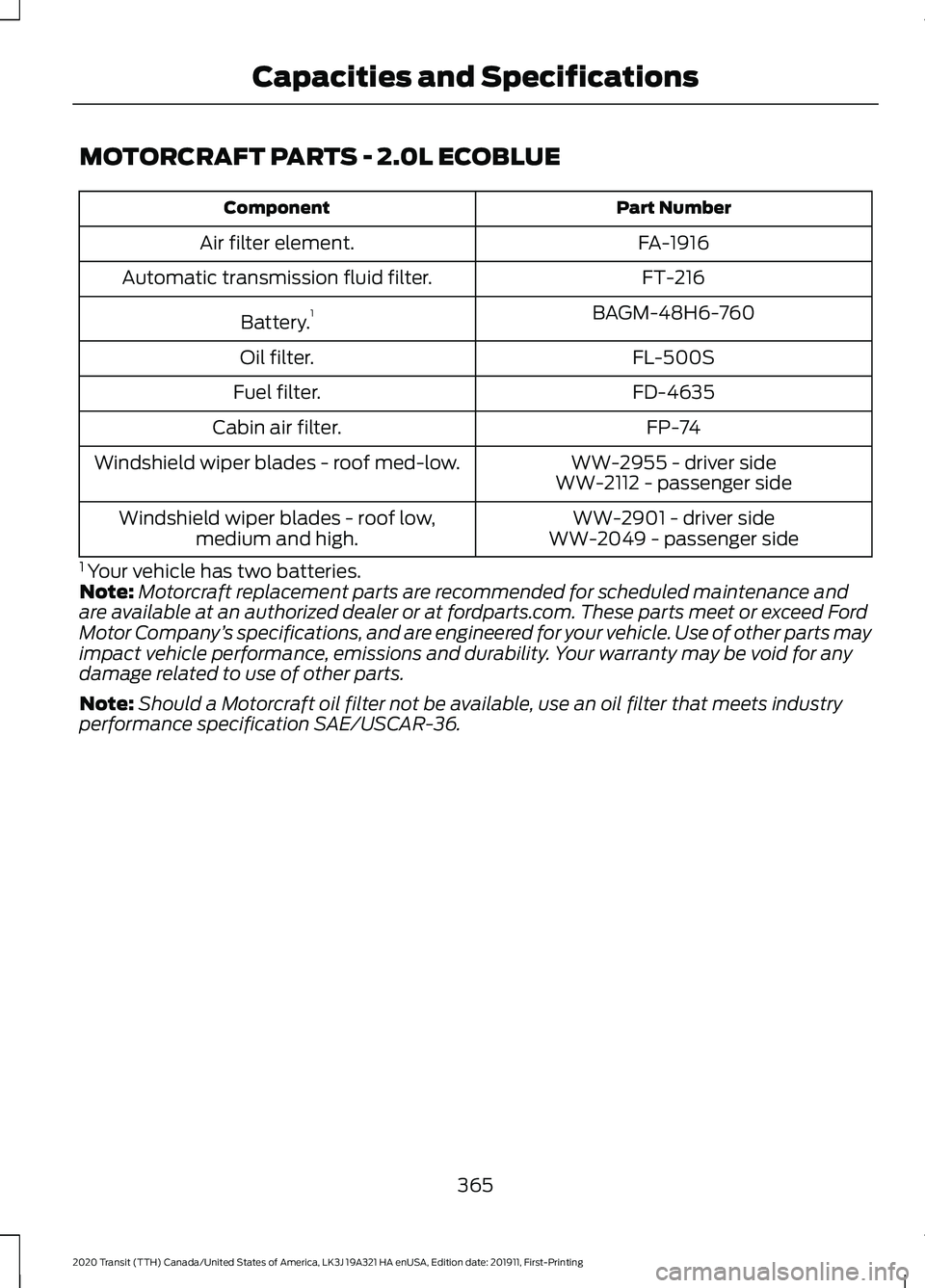
MOTORCRAFT PARTS - 2.0L ECOBLUE
Part Number
Component
FA-1916
Air filter element.
FT-216
Automatic transmission fluid filter.
BAGM-48H6-760
Battery. 1
FL-500S
Oil filter.
FD-4635
Fuel filter.
FP-74
Cabin air filter.
WW-2955 - driver side
Windshield wiper blades - roof med-low.
WW-2112 - passenger side
WW-2901 - driver side
Windshield wiper blades - roof low,
medium and high. WW-2049 - passenger side
1 Your vehicle has two batteries.
Note: Motorcraft replacement parts are recommended for scheduled maintenance and
are available at an authorized dealer or at fordparts.com. These parts meet or exceed Ford
Motor Company ’s specifications, and are engineered for your vehicle. Use of other parts may
impact vehicle performance, emissions and durability. Your warranty may be void for any
damage related to use of other parts.
Note: Should a Motorcraft oil filter not be available, use an oil filter that meets industry
performance specification SAE/USCAR-36.
365
2020 Transit (TTH) Canada/United States of America, LK3J 19A321 HA enUSA, Edition date: 201911, First-Printing Capacities and Specifications
Page 373 of 529
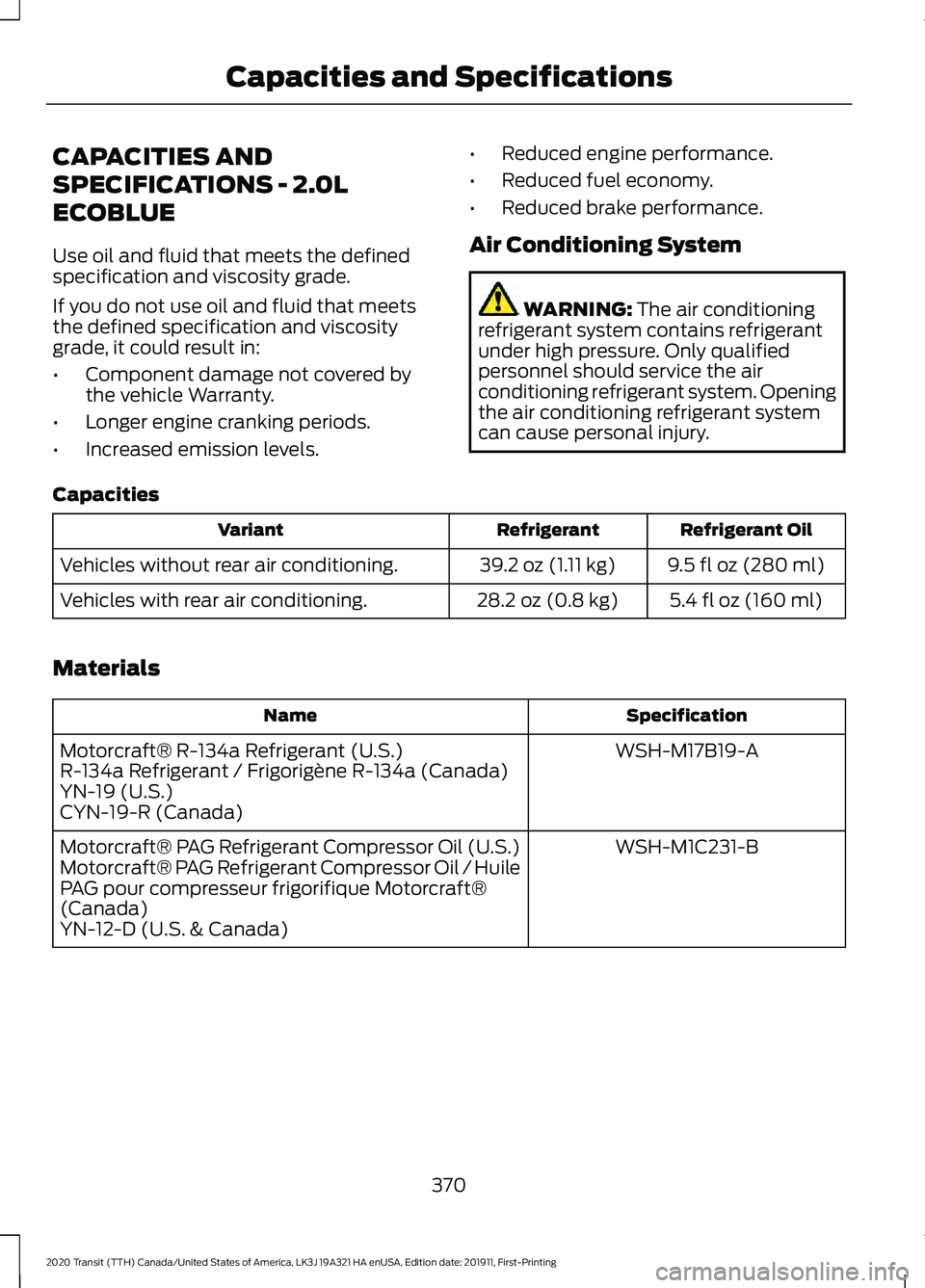
CAPACITIES AND
SPECIFICATIONS - 2.0L
ECOBLUE
Use oil and fluid that meets the defined
specification and viscosity grade.
If you do not use oil and fluid that meets
the defined specification and viscosity
grade, it could result in:
•
Component damage not covered by
the vehicle Warranty.
• Longer engine cranking periods.
• Increased emission levels. •
Reduced engine performance.
• Reduced fuel economy.
• Reduced brake performance.
Air Conditioning System WARNING: The air conditioning
refrigerant system contains refrigerant
under high pressure. Only qualified
personnel should service the air
conditioning refrigerant system. Opening
the air conditioning refrigerant system
can cause personal injury.
Capacities Refrigerant Oil
Refrigerant
Variant
9.5 fl oz (280 ml)
39.2 oz (1.11 kg)
Vehicles without rear air conditioning.
5.4 fl oz (160 ml)
28.2 oz (0.8 kg)
Vehicles with rear air conditioning.
Materials Specification
Name
WSH-M17B19-A
Motorcraft® R-134a Refrigerant (U.S.)
R-134a Refrigerant / Frigorigène R-134a (Canada)
YN-19 (U.S.)
CYN-19-R (Canada)
WSH-M1C231-B
Motorcraft® PAG Refrigerant Compressor Oil (U.S.)
Motorcraft® PAG Refrigerant Compressor Oil / Huile
PAG pour compresseur frigorifique Motorcraft®
(Canada)
YN-12-D (U.S. & Canada)
370
2020 Transit (TTH) Canada/United States of America, LK3J 19A321 HA enUSA, Edition date: 201911, First-Printing Capacities and Specifications